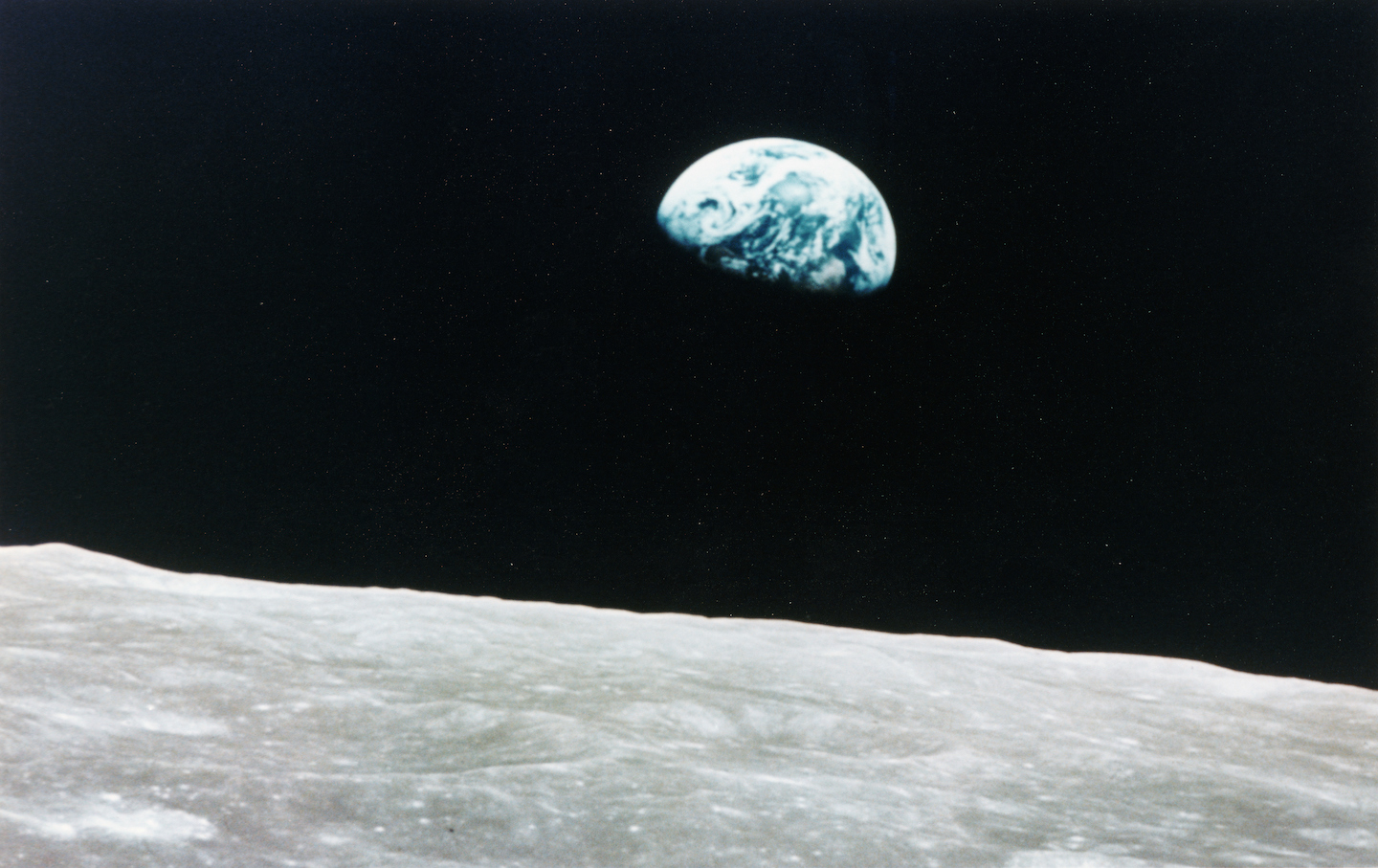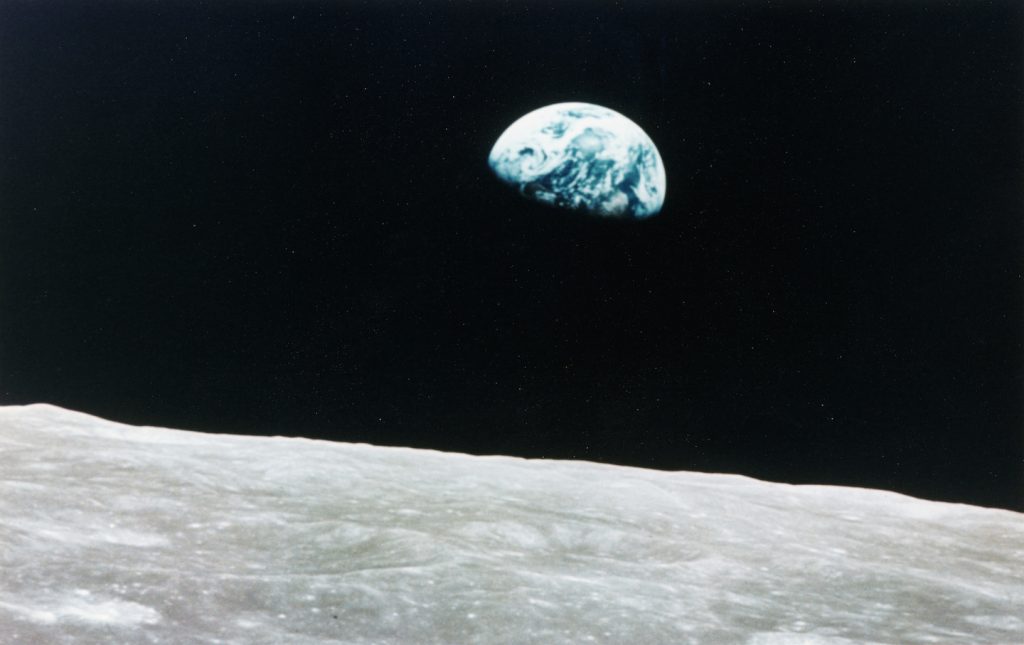
Her new novel, a time travel story called Sea of Tranquility, presents a universe lacking in loose ends or messiness.
It doesn’t pay to think too hard about the nuances of fictional time travel. Let the rickety carapace of the plot fall away—the clutter of paradoxes, loops, body doubles—and the stories within are pure parables: determinism versus agency, choices followed by consequences (intended and unintended), the past affecting the future. They are about romantic fatalism (The Time Traveler’s Wife), loving your dad (About Time), loving your wife (Needle in a Timestack), the struggle to control intellectual property (Primer). Following the logistics too rigorously just gets you tangled up in the leash. As a lissome French physicist advises in Tenet (which is about loving your bro), “Don’t try to understand it. Just feel it.”
Sea of Tranquility, by Emily St. John Mandel, keeps things simple as it puddle-jumps across a few different eras: Canada in 1912, New York in 2020, a book tour in 2203, and a moon colony in 2401. We start with Edwin, the second son of a powerful British family, who encounters a man posing as a priest in the woods of Caiette. Then there’s Mirella, who goes to a concert in Brooklyn and has an unsettling conversation with another attendee. After that, we follow Olive on her trip from the moon to the United States, as news breaks of a highly contagious virus emerging in Australia. The novel she’s promoting, about a flu that ravages humanity, also describes a surreal incident in which she listened to a violinist in an airship terminal.
We spend the most time with a moon colonist, Gaspery, who joins his brilliant, evasive sister Zoey in her work at the shadowy Time Institute. The institute, she explains, has identified anomalous moments in which disparate eras seem to bleed into one another like a corrupted file. This might confirm a theory beloved by dorm-room philosophers—that life as we know it is a simulation.
Gaspery’s assignment at the institute: travel through time to gather data about the anomaly and interview witnesses. Anyone who attempts to alter history is caught, given a new identity, and framed for a serious crime, then left to rot in jail in some distant era. Gaspery, the good soldier, has no trouble following these rules, until he does. Though he knows Olive will die on Earth from the virus, he warns her to take the earliest spaceship off-planet. The aftereffects cascade from there, as he and Zoey race to set everything right.
What does time travel get us in Sea of Tranquility? It yields its moral readily: “If definitive proof emerges that we’re living in a simulation, the correct response to that news will be so what,” Gaspery declares. “A life lived in a simulation is still a life.” I’d apologize for the spoiler, but it doesn’t seem possible to spoil this book. You may have already predicted that Gaspery turns out to be both Edwin’s false priest and Mirella’s concertgoer. After Zoey rescues him from time jail, he lives on a farm in Oklahoma and then by busking in an airship terminal; thus he turns out to be Olive’s violinist, too. The plot unfolds with a sedate inevitability: Gaspery realizes that he caused the very anomaly that he set out to investigate. Where he once felt rudderless and baffled by his own life, it is now revealed to be a clean, closed loop. Mandel ties up every loose end. There is no pure coincidence, only design waiting to be disclosed.
Coincidence was essential to the magic of Station Eleven (2014), which made Mandel a household name. The novel’s enduring accomplishment is in conjuring a postapocalypse that re-enchants our vision of the world. “Consider the snow globe,” Mandel rhapsodizes. “Consider the mind that invented those miniature storms, the factory worker who turned sheets of plastic into white flakes of snow…the assembly-line worker who watched the globe glide past on a conveyer belt somewhere in China.” Naturally, people primarily read Station Eleven, with its heroic traveling theater troupe, as a celebration of culture in times of crisis; I can’t remember the last time I’ve read such glowing paeans to supply chains. After civilization collapses, the characters yearn not just for their pre-pandemic lives but for modernity and its sprawling systems, for organized activity in all its forms. Perhaps global capitalism is as human an endeavor as performing Shakespeare; it, like art, connects far-flung people in unlikely, even preposterous, ways. A world where people are fragmented and focused wholly on survival does not encourage chance encounters; these are only possible in a world that’s populous, mobile, busy. If Sea of Tranquility gives off the slightly chilly air of a controlled lab experiment, Station Eleven teemed with enough life that you could forget its underlying artifice.
Mandel’s 2020 novel The Glass Hotel, in a more realist mode, also concerned itself with contingency and how people suddenly find themselves in different realities. Vincent, a bartender, enters what she calls the “kingdom of money” after she marries a financier, Alkaitis; Leon, who loses everything after the collapse of Alkaitis’s Ponzi scheme, tumbles into a “shadowland” of people scraping by without homes or steady employment. Alkaitis himself, serving a life sentence, mentally inhabits an imagined “counter-life” in which he fled somewhere warm and without extradition treaties. The characters all understand their lives to be merely one possible version of events, one in an infinite set of timelines. Sharing a few characters with Station Eleven—though not its inciting disaster—The Glass Hotel is haunted by “what ifs” that Mandel declines to resolve or justify. What results is an eerie poignancy that’s difficult to explain and even harder to dispel.
When Sea of Tranquility repeats that gambit, its effect is less distinct. Mirella, a background figure in The Glass Hotel, gets a fuller backstory; Gaspery’s and Alkaitis’s cellmates happen to share a surname. But why? Is Mandel merely confirming the power of fiction to explore alternative timelines? Is she tipping us off that all these people are, indeed, living in a simulation (that is, that they’re characters in a novel)? Is she establishing an extended universe, custom-built for hard-core fans and easy Hollywood adaptation? We get hints that Mirella’s era will soon be overtaken by something like the Covid-19 pandemic—is this meant to make our own reality feel more fictive? The problem isn’t that we’re left with open-ended questions, but that these questions are so easily shrugged off. Where The Glass Hotel was spookily destabilizing, Sea of Tranquility’s temporal hijinks feel noncommittal.
The novel’s dominating aesthetic is supremely orderly, its chapters arranged with appealing symmetry. Every disturbance falls into its proper place: The stranger Mirella meets in the park is revealed to be a familiar, benevolent face from her childhood; the publicist who keeps showing up unexpectedly is revealed to be a time traveler herself. Sea of Tranquility is filled with images of cleanly sealed, contained environments, like the domes arching over the moon colonies, programmed with artificial light.
There is both elegance and tenderness in Mandel’s narrative design: A seemingly peripheral figure becomes the protagonist, moving the plot’s center of gravity; after using his aimless youth to set events in motion, in his old age he finds himself finally at rest, contemplating what it means to be “a still point in a ceaseless rush.” Mandel doesn’t risk the kludge of ornate world-building; she sketches out the setting and her characters with minimal lines. But as a result, their choices seem to emerge from the requirements of the plot, not from the murk of psychology. The spareness of the prose, then, works against its animating principle: Even as Sea of Tranquility argues for the weight of experience, it leaves you with the nagging suspicion that the interior life of a hologram might be hollow.
The praise for, and popularity of, Mandel’s recent novels is commonly linked to how adroitly she traverses the borderland between sci-fi and literary fiction, carving out some middle ground between the tropes of the former and the depths of the latter. Sea of Tranquility takes its dual citizenship to comic extremes: one foot in the realm of spacefaring and robots and menacing über-bureaucrats; the other in the land of meta-literary gamesmanship. Olive is overtly an author stand-in, and Mandel bulks out her chapters with musings on the postapocalypse that could have been lifted from her own public appearances. (An unfortunate amount of textual square footage is given over to the real-life annoyances of artistic success: indiscreet publicists, talkative cab drivers, readers’ microaggressive comments.)
At one point, Olive tells a journalist that she’s working on “this crazy-sci fi thing” and blames it on cabin fever: “I think I just wanted to write something set as far away as possible from my apartment.” Mandel, though, doesn’t imagine herself entirely out of lockdown—just in a more exotic one, trading a New York apartment for one on the moon. The 2203 chapters suggest that the features of so-called genre fiction are just set dressing, and that what’s essential are emotional states: the loneliness of a child without friends to play with; the headaches of a husband working all day in virtual reality. Olive, for her part, keeps returning to one stark fact: She was supposed to have died in the plague, but was spared.
Meanwhile, we, on our Earth and in our timeline, are almost excruciatingly aware of our interdependence, of the ugly contingencies that undergird our lives—of the unequal distribution of suffering that enables a select few to remain comfortable. Speculative fiction can help us wade through this muck. Mandel, though, prefers to create an immaculate surface. For her, science fiction allows us only enough escape from our context to let us regard it from a softening distance. And perhaps time travel, in Sea of Tranquility, works to simplify the equation. In this universe, you can put a name and a face to the person to whom you owe your life. In this universe, it’s only one person.
